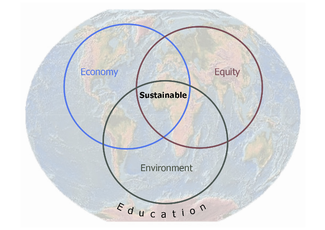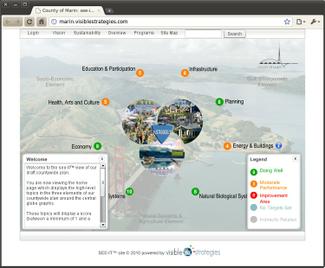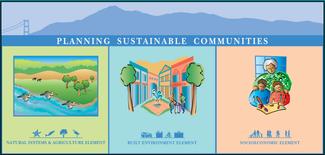
Reinventing the General Plan
A Project of the California Planning Roundtable
With support from the American Planning Association, California Chapter
Great Model: Marin County
Featured Principles: Manage Change, Make Life Better, Steward and Enhance the Environment
- Context
- Sustainability
- Clear Tracking
- Simplified Organization
- Challenges and Lessions
- Background Information
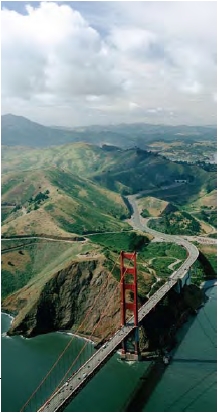
Known for progressive politics and scenic beauty, Marin County identified sustainability, particularly climate change, as a chief concern in its Countywide Plan Update. This suburban/rural Bay Area county, with a population of just over 250,000, developed a Plan that took on the challenge of aligning the built environment and socioeconomic activities with the natural systems that support life. Organized in an innovative and simplified way, with just three elements, the Plan also features impressively specific benchmarks and measures for accountability at all levels of County government. The County developed the Plan over seven years, and since being adopted November 6, 2007, it has been honored with awards at the state and national level for pioneering efforts in planning sustainable communities. This plan is a great model to help other communities address sustainability in a sophisticated yet easy to use general plan.
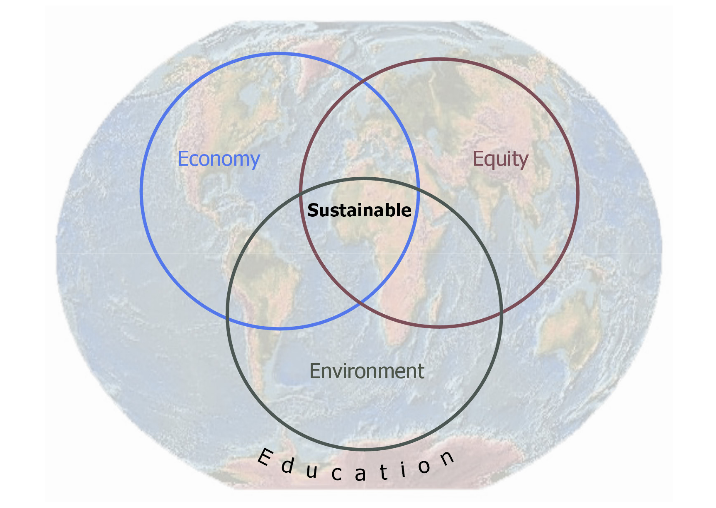
As part of its pioneering efforts towards sustainability, the Marin Countywide Plan includes an analysis of Marin County's ecological footprint and is the first general plan to include an analysis of greenhouse gases in the EIR. The Plan was written prior to the passage of AB 32, but due to extensive research and forward-thinking, the Plan remains up-to-date and current with a majority of the new legislation regarding climate change. Additionally, the Atmosphere and Climate section addresses both mitigation measures and adaptation strategies for a changing climate.
The Plan calls upon the County to demonstrate sustainable programs and practices in every department, which is intended to help the local communities implement sustainability policies that work towards the desired goals and outcomes identified in the Plan. Quantifiable progress is being made towards the desired goals and outcomes.
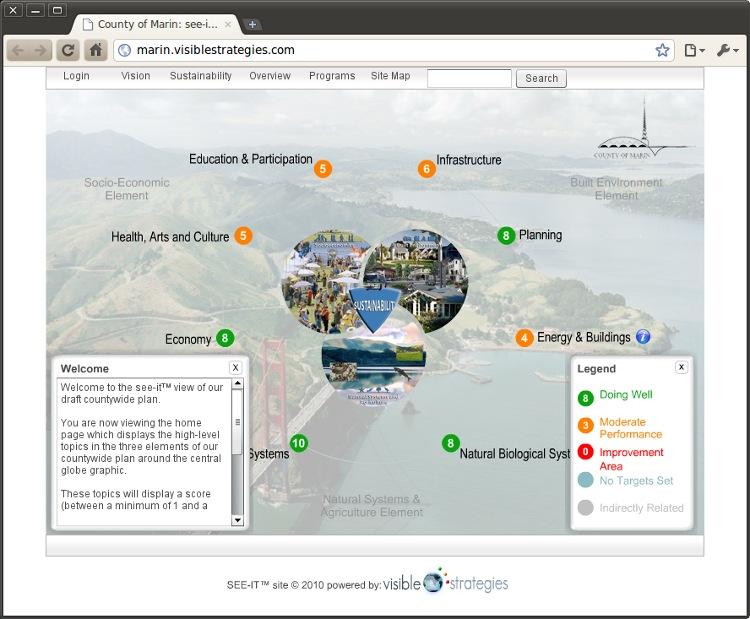
Although not required in general plans, the Marin Countywide Plan identifies indicators, benchmarks and targets that serve as a feedback loop to help monitor the progress towards reaching the desired outcomes. Implementation charts are included in every element that identify the responsibilities, potential funding sources, priorities and estimated time frames for the programs. The implementation strategies are easy to understand and progress can be tracked by the public through the County's "See-it Viewer" at http://marin.visiblestrategies.com/. Simple and visually striking, this site gives numeric scores that grade how well the county is doing to achieve its general plan goals. Implementation charts have been integrated into the Annual Work Program and are considered in employment evaluations of management staff.
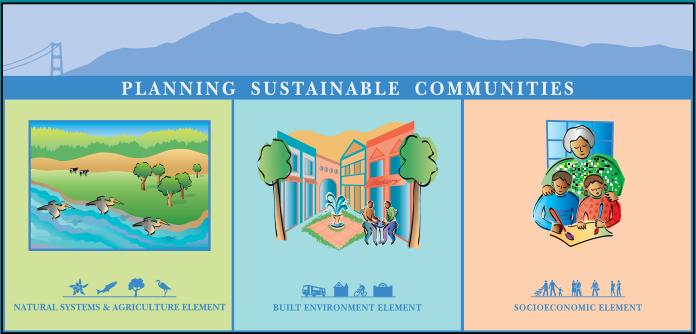
The plan has an innovative organization that brings all required elements into just three chapters covering natural systems, the built environment and socioeconomics. Each element is complete with background information, goals and outcomes, and a framework for implementing programs to reach the desired goals. The optional Socioeconomic Element addresses a wide range of topics including quality childcare, public safety, diversity, education, public health, and arts and culture. Information on the qualities of each element can be found here.
Guiding Principles, developed by a Sustainability Working Group, are listed in the introduction and again in a chart at the end of each section illustrating how each goal in the Plan relates to these Principles. The concept of sustainability pervades all three elements, emphasizing the linkages among equity, the economy, and the environment in a "Why is this Important?" paragraph following each goal. In addition, there are indicators listed at the end of each section that will track progress towards or away from the goals.

The biggest challenge, County staff reported, was keeping all of the pieces of the Plan moving together throughout the long public hearing process. The public hearing process was difficult to manage and took longer than anticipated, but was an essential part of developing community ownership of the Plan. Data changed multiple times throughout the development of the Plan and it was a challenge to ensure that all parts were kept current. Additionally, The risk of litigation is high in Marin County, which added extra costs and complexity to the process.
It is extremely important to have all stakeholders agree to a timeline in the beginning and to adhere to the timeline. Once the Marin County Board of Supervisors became involved in adhering to the timeline, the project was kept on-track. If they were to do it again, County Staff and Board of Supervisors would put greater emphasis on adhering to the agreed upon schedule and require the staff and Planning Commission to go back to Board of Supervisors to request changes to the schedule.
The Trends, Issues and Strategies Report, created with Working Groups to guide the development of the General Plan, was successful. Upon reflection, however, County Staff felt they should have prepared the trends section prior to the meetings rather than having the public spend time helping to identify the trends. Otherwise the working groups were extremely valuable in developing the Plan.
It was in the best interest of the County to understand and staying current with the science involved in the Plan because when new legislation came up such as AB 32, the County was already up-to-date on climate change issues. The Plan was written before the passage of AB 32 and was based upon the Kyoto Protocol. Now that AB 32 legislation is in place, the Plan would be restructured to base it on AB 32.
Additionally, the County would try to create a shorter plan that is easier to navigate because the length makes it somewhat cumbersome for the general public to read.
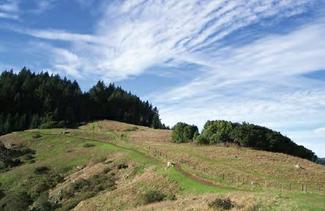
Community Description
2005 population: 252,600; 606 square miles of land and water.
The main industries in Marin include real estate and construction, health services, technology and multimedia, agriculture, entertainment and tourism, and wealth management.
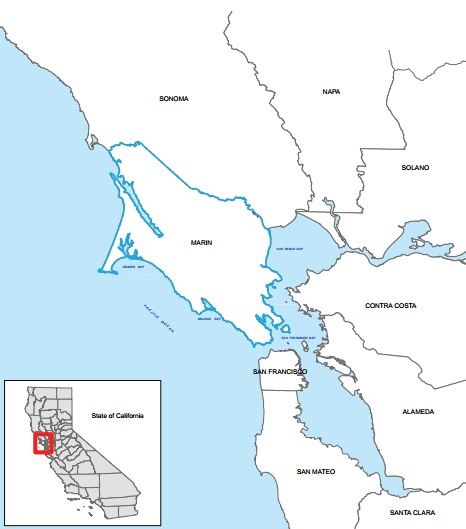
Timeframe of Plan Development
The Countywide Plan was begun in April 2000, and the Plan and EIR were approved in November of 2007, winning awards at the state and national level for sustainability including the CCAPA Comprehensive Planning, Large Jurisdiction Award and the National Planning Excellence Award for Implementation.
The County concurrently implemented the Plan through the creation of the Sustainability Team and Affordable Housing Strategists. The Sustainability Team continues to play an important role in making sustainable policies and programs "business as usual" in Marin.
How did the actual schedule conform to the expected schedule?
The expected schedule was 2000-2004 and the Plan was approved in 2007; three years after the expected approval date.
Community Reaction
The community was kept informed and involved throughout the development of the Plan, which helped create a plan that the community supported in the end.
The sustainability elements of the Plan were very well received by the community due, in part, to the extensive public education and outreach efforts.
The only really contentious parts of the Plan revolved around land use issues such as density, traffic, agriculture, and the creation of the Baylands Corridor, which limited development opportunities and increased environmental scrutiny in certain areas. The Baylands Corridor has gained more support as recent data on climate change has emerged indicating the importance of preserving the Baylands.
Adoption Process Details
All told, the adoption process ended up taking around 38 planning commission hearings and about six Board of Supervisor hearings. The first round of hearings at the planning commission, which were intended to simply focus on freezing the project description for CEQA purposes, took around one year and approximately 23 hearings. The actual adoption process went much more quickly and smoothly, thanks in large part to obtaining support from the Board of Supervisors and direction to stick within the time limits of the revised schedule. Extra planning commission hearings were allowed to occur, provided they occurred within the overall time limits.
Public Participation & Stakeholder Involvement
The community was heavily involved in the development of the Plan beginning in early 2000 with public education workshops on sustainability to inform the public on the issues to be addressed in the Plan. A large amount of public input came during the Planning Commission meetings and these comments were incorporated into the Plan. Additionally, a number of interested groups formed and got involved to support everything from more trees to no growth.
Committees
Four working groups contributed to the Plan, covering areas of the Built Environment; Natural Systems; Economy, Equity and Culture; and Sustainability. There were 17 meetings in the first round, resulting in the Trends, Issues and Strategies Report, which included all of the great ideas from the meetings (available at http://www.co.marin.ca.us/depts/cd/main/fm/reports.cfm). The working groups weren't asked to agree on the issues in the Report, which allowed the document to move quickly.
Public Workshops
There were 115 public meetings with over 2,000 participants in all. The public meetings included everything from Planning Commission Meetings to educational public outreach.
Public Website
Public access to the Plan throughout the development process was provided through the website: http://www.co.marin.ca.us/depts/CD/main/fm/TOC.cfm.
Other County Departments' Involvement
Other departments were involved with internal review and with the development of the indicators. The Health and Human Services Department was active in the helping draft the sections dealing with healthy communities, Public Works provided engineering and infrastructure input throughout the sections, and Parks and Open Space was also heavily involved in many of the sections. The creation of the indicators required input from almost all County departments as well as outside organizations, commissions and non-profits.
Other Jurisdictions' Involvement
Other jurisdictions were involved early in the process through a Cities-County organization in existence at the time. All the Cities and Marin County participated in the preparation of a housing element workbook which was included in the Built Environment Element, but was approved as separate Housing Elements to meet State requirements.
Legal and Policy Context
California State Law requires the General Plan. Marin County revised the Plan to reflect the theme of planning sustainable communities and to recognize the adoption of the Marin County government's first strategic plan in 2001 that strives to achieve excellence in public service. In addition, the Plan addresses local concerns about the size of Marin County's ecological footprint and greenhouse gas emissions.
Connections to Jurisdictional Budget
Sustainability became a major priority in the County budget during the preparation and adoption of the Plan. There are policies within the Plan that give priority to Capitol Improvement Projects that reduce fossil fuel consumption and greenhouse gas emissions.
Adapting to changing conditions
The implementation principles state that the indicators may be adjusted over time as long as they remain consistent with the intent of the Plan. This allows the Plan to adapt to changing conditions such as the monitoring of greenhouse gases, which is still in the early stages and is likely to undergo changes in the future.
The County intends to draft a report on its progress in relation to the indicators identified in the Plan and to establish a form to amend the strategies or the indicators to achieve the desired outcomes of the Plan.
Consideration of Regional Issues
Regional housing numbers were used in the Housing Element, which was approved separately from the Plan and is included in the Built Environment Element.
Regional efforts for creating trails, containing sprawl, preserving open space, reaching regional air quality targets and adhering to regional transportation plans and traffic models were all factored into the Plan.
Actual Costs
The Plan including public participation, supporting documents (excluding the EIR), and extra hire staff and consultants cost $1 million. The environmental documents and outside legal counsel also cost $1 million. The County did not calculate the cost of existing staff positions.
Actual Costs vs. Expected Costs
The County originally hoped to do both the Plan and EIR for $1 million and did not originally budget for outside counsel. Time delays also added costs by requiring updated consultant information.
Accessing the Plan
The Plan is available online.
Free versions of all drafts of the Countywide Plan may be obtained on CD by contacting Sharon Silver at (415) 499-7874 or Linda Alves at (415) 499-6269. Print versions of the adopted Plan are available for review at all local libraries, or can be purchased for $50 from the Community Development Agency front reception desk. A readable, "coffee table" quality summary of the Plan, entitled Sustainable Marin - Nature, Built Environment, And People, may be downloaded or purchased as listed above.
Planning Staff and Consultants
In-house staff:
- Alex Hinds, Marin County Community Development Director
- Dawn Weisz, Principal Planner
- Plus an additional 24 FTE staff
- Lead consultant: Terry Watt, Managing Consultant for Final Draft
- Technical subconsultants: 23 subconsultants
Name of CPR Preparer of this Model
David Early, with assistance from Heather Martinelli of Design, Community & Environment
Name of Primary Point of Contact at the Jurisdiction
Dawn Weisz, Principal Planner and Alex Hinds, Former Community Development Director
CPR Peer Reviewers
David Booher, Cathy Creswell, Linda Dalton, Al Zelinka
CPR Project Team
Elaine Costello, Project Manager; Co-Chairs Cathy Creswell and Janet Ruggiero; Craig Beebe, Project Assistant
Created with support from the California Chapter of the American Planning Association.
The Catalog
Our catalog contains a number of General Plan "Great Model" examples. Browse the entire catalog
Browse by Principle
- Create a Vision
- Manage Change
- Make Life Better
- Build Community Identity
- Promote Social Equity and Economic Prosperity
- Steward and Enhance the Environment
- Engage the Whole Community
- Look Beyond Local Boundaries
- Prioritize Action
- Be Universally Attainable
Browse by tag:
awards city climate-change context county equity graphics growth-management health implementation infill mature-community organization participation preservation redevelopment region rural smart-growth suburban sustainability town urban urban-design web-strategies
